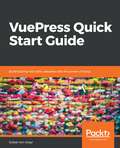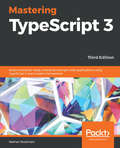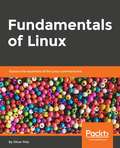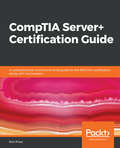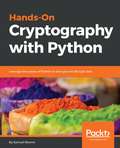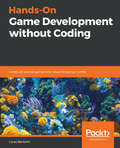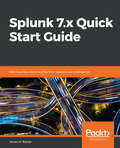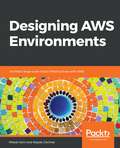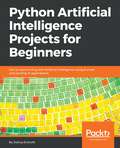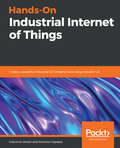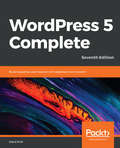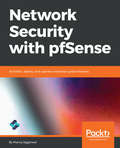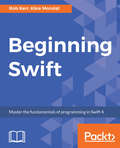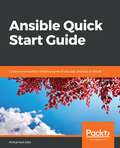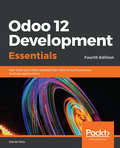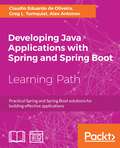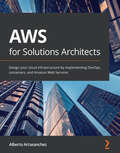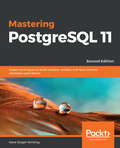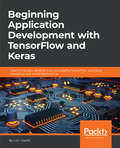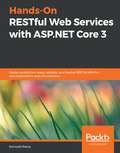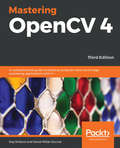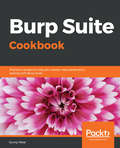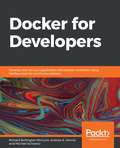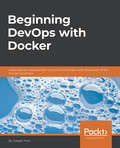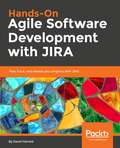- Table View
- List View
VuePress Quick Start Guide: Build blazing-fast static websites with the power of Vue.js
by Sufyan Bin UzayrA fast paced that will teach you to build Static JavaScript Sites and Amazing Web Apps Using VuePressKey FeaturesBuild quick, SEO-friendly static websites with VuePress and Vue.jsDevelop and maintain your sites long termUse the power of Vue + webpack, and develop custom themes with VueBook DescriptionWhat are static site generators, why do you need them, and how are they better than general blogging or writing or content tools? This book answers all those questions as you learn how to build sites with VuePress. This book teaches you how to build static sites in VuePress in no time. All the site content is rendered as HTML by VuePress and is then executed as a single-page web app. This means everything works fast and loads quickly. You will start by installing and setting up the VuePress static site generator. You will learn about the powerful JavaScript framework Vue.js, which underpins VuePress, looking at its uses and advantages. You will then dig deep into the specifics of VuePress, covering content creation in Markdown, customization, internationalization, and deployment. You will also learn about security methods, configuration files for new installations, and many other techniques to have you building your own sites safely and quickly.By the end of the book, you will have built your own static website by leveraging the power of Vue.js and VuePress.What you will learnPut together a simple site in MarkdownUse VuePress to generate a super-fast static siteCustomize the appearance of your VuePress site using custom themesWork with internationalization and localize your site in multiple languagesSet up a custom home page with a call to action button as well as other pages and a navigation menuDeploy your JavaScript site to services such as Heroku, and NetlifyWho this book is forIf you want to create static sites easily, this book is for you. No knowledge of VuePress is required, but some experience with JavaScript will be helpful.
Mastering TypeScript 3 - Third Edition: Build enterprise-ready, industrial-strength web applications using TypeScript 3 and modern frameworks, 3rd Edition
by Nathan RozentalsThe book is for intermediate/experienced web developers with knowledge of JS and basics of JS who wants to delve into the advanced concepts of TypeScripts and build enterprise-ready web and desktop applications using the only TypeScript at the front and back end. Learn how to use TypeScript with a multitude of modern frameworks, and choose the best framework for your project requirements.
Fundamentals of Linux: Explore the essentials of the Linux command line
by Oliver PelzDevelop a solid understanding of the important command-line tools and utilities in LinuxKey FeaturesDelve into the fundamentals of LinuxExplore and work with virtualization, command lines, and Bash shell scriptsUse special file permission flags such as setuid and setgidBook DescriptionLinux is a Unix-like operating system assembled under the model of free and open source software development and distribution. Fundamentals of Linux will help you learn all the essentials of the Linux command line required to get you started. The book will start by teaching you how to work with virtualization software and install CentOS 7 Linux as a VM. Then, you will get to grips with the workings of various command line operations, such as cursor movement, commands, options, and arguments. As you make your way through the chapters, the book will not only focus on the most essential Linux commands but also give an introduction to Bash shell scripting. Finally, you will explore advanced topics, such as networking and troubleshooting your system, and you will get familiar with the advanced file permissions: ACL, setuid, and setgid. Fundamentals of Linux includes real-world tasks, use cases, and problems that, as a system administrator, you might encounter in your day-to-day activities.What you will learnExplore basic and advanced command-line conceptsInstall Linux, work with VirtualBox, and install CentOS 7 in VirtualBox Work with the command line efficiently and learn how to navigate through the Linux filesystemCreate file and user group permissions and edit filesUse Sticky bit to secure your Linux filesystemDefine and remove ACL from Linux filesWho this book is forFundamentals of Linux is for individuals looking to work as a Linux system administrator.
CompTIA Server+: A comprehensive, end-to-end study guide for the SK0-004 certification, along with mock exams
by Ron PriceThis book is targeted towards professionals seeking to gain the CompTIA Server+ certification. People coming from a Microsoft background with basic operating system and networking skills will also find this book useful. Basic experience working with system administration is mandatory.
Hands-On Cryptography with Python: Leverage the power of Python to encrypt and decrypt data
by Samuel BowneLearn to evaluate and compare data encryption methods and attack cryptographic systemsKey FeaturesExplore popular and important cryptographic methodsCompare cryptographic modes and understand their limitationsLearn to perform attacks on cryptographic systemsBook DescriptionCryptography is essential for protecting sensitive information, but it is often performed inadequately or incorrectly. Hands-On Cryptography with Python starts by showing you how to encrypt and evaluate your data. The book will then walk you through various data encryption methods,such as obfuscation, hashing, and strong encryption, and will show how you can attack cryptographic systems. You will learn how to create hashes, crack them, and will understand why they are so different from each other. In the concluding chapters, you will use three NIST-recommended systems: the Advanced Encryption Standard (AES), the Secure Hash Algorithm (SHA), and the Rivest-Shamir-Adleman (RSA). By the end of this book, you will be able to deal with common errors in encryption.What you will learnProtect data with encryption and hashingExplore and compare various encryption methodsEncrypt data using the Caesar Cipher techniqueMake hashes and crack themLearn how to use three NIST-recommended systems: AES, SHA, and RSAUnderstand common errors in encryption and exploit themWho this book is forHands-On Cryptography with Python is for security professionals who want to learn to encrypt and evaluate data, and compare different encryption methods.
Hands-On Game Development without Coding: Create 2D and 3D games with Visual Scripting in Unity
by Lucas BertoliniDevelop your own games with Unity 2D/3D Game Kit and use it for your presentations, kids education, level design, game design, proofs of concept, or even just for fun!Key FeaturesBuild your first ever video game using Unity 2D/3D Game kitLearn how to create game levels, adding props, giving behaviours to objects and working on gameplayStep by step instructions on creating your own AI enemy and interacting with itBook DescriptionHands-On Game Development without Coding is the first Visual Scripting book in the market. It was tailor made for a non programing audience who are wondering how a videogame is made.After reading this book you will be able to develop your own 2d and 3d videogames and use it on your presentations, to speed up your level design deliveries, test your game design ideas, work on your proofs of concept, or even doing it just for fun.The best thing about Hands-On Game Development without Coding is that you don’t need any previous knowledge to read and understand the process of creating a videogame. It is our main focus to provide you with the opportunity to create a videogame as easy and fast as possible.Once you go through the book, you will be able to create player input interaction, levels, object behaviours, enemy AI, creating your own UI and finally giving life to your game by building it.It’s Alive!What you will learnUnderstanding the Interface and kit flow. Comprehend the virtual space and its rules.Learning the behaviours and roles each component must have in order to make a videogame.Learn about videogame developmentCreating a videogame without the need of learning any programming languageCreate your own gameplay HUD to display player and Enemy informationWho this book is forThis book is for anyone who is interested in becoming a game developer but do not posses any coding experience or programming skills. All you need is a computer and basic software interface knowledge.
Splunk 7.x Quick Start Guide: Gain business data insights from operational intelligence
by James H. BaxterLearn how to architect, implement, and administer a complex Splunk Enterprise environment and extract valuable insights from business data.Key FeaturesUnderstand the various components of Splunk and how they work together to provide a powerful Big Data analytics solution. Collect and index data from a wide variety of common machine data sourcesDesign searches, reports, and dashboard visualizations to provide business data insightsBook DescriptionSplunk is a leading platform and solution for collecting, searching, and extracting value from ever increasing amounts of big data - and big data is eating the world! This book covers all the crucial Splunk topics and gives you the information and examples to get the immediate job done. You will find enough insights to support further research and use Splunk to suit any business environment or situation.Splunk 7.x Quick Start Guide gives you a thorough understanding of how Splunk works. You will learn about all the critical tasks for architecting, implementing, administering, and utilizing Splunk Enterprise to collect, store, retrieve, format, analyze, and visualize machine data. You will find step-by-step examples based on real-world experience and practical use cases that are applicable to all Splunk environments. There is a careful balance between adequate coverage of all the critical topics with short but relevant deep-dives into the configuration options and steps to carry out the day-to-day tasks that matter.By the end of the book, you will be a confident and proficient Splunk architect and administrator.What you will learnDesign and implement a complex Splunk Enterprise solutionConfigure your Splunk environment to get machine data in and indexedBuild searches to get and format data for analysis and visualizationBuild reports, dashboards, and alerts to deliver critical insightsCreate knowledge objects to enhance the value of your dataInstall Splunk apps to provide focused views into key technologiesMonitor, troubleshoot, and manage your Splunk environmentWho this book is forThis book is intended for experienced IT personnel who are just getting started working with Splunk and want to quickly become proficient with its usage. Data analysts who need to leverage Splunk to extract critical business insights from application logs and other machine data sources will also benefit from this book.
Designing AWS Environments: Architect large-scale cloud infrastructures with AWS
by Mitesh Soni Wayde GilchristDesign and create robust and resilient distributed solutions with AWSKey FeaturesDesign and secure virtual private network environments on the AWS cloudDeploy appropriate instance types and sizes based on performance and cost requirementsGain proficiency and confidence when designing virtual cloud environmentsBook DescriptionAmazon Web Services (AWS) provides trusted,cloud-based solutions to help you meet your business needs. Running your solutions in the AWS Cloud can help you get your applications up and running faster while providing the security to meet your compliance requirements. This book begins by familiarizing you with the key capabilities to architect and host applications, websites, and services on AWS. We explain the available options for AWS free tier with virtual instances and demonstrate how you can launch and connect them. Using practical examples, you’ll be able to design and deploy networking and hosting solutions for large deployments. Finally, the book focuses on security and important elements of scalability and high availability using AWS VPC, Elastic Load Balancing, and Auto scaling. By the end of this book, you will have handson experience of working with AWS instances,VPC, Elastic Load Balancing, and Auto scalingrelated tasks on Amazon Web Services.What you will learnEstablish how to launch EC2 instances and log inWork with Linux and Windows instancesUnderstand Amazon VPC networking creation with and without a wizardDesign, create, and secure a Virtual Private CloudAutoscale instances based on the increase and decrease in trafficDeploy applications in a highly available and fault-tolerant mannerLoad balance the requests with Elastic Load BalancingMake your applications highly available through load balancing, multi-AZ deployments, and auto scalingWho this book is forThis book is for new and aspiring individuals who are preparing or gearing up for a solutions architect role. You’ll also find this useful if you’re an IT professional such as beginners, cloud architects, and cloud solution providers, or DevOps engineer who is preparing to design and deploy large solutions on AWS. No experience with AWS is required.
Python Artificial Intelligence Projects for Beginners: Get up and running with Artificial Intelligence using 8 smart and exciting AI applications
by Joshua EckrothBuild smart applications by implementing real-world artificial intelligence projectsKey FeaturesExplore a variety of AI projects with PythonGet well-versed with different types of neural networks and popular deep learning algorithmsLeverage popular Python deep learning libraries for your AI projectsBook DescriptionArtificial Intelligence (AI) is the newest technology that’s being employed among varied businesses, industries, and sectors. Python Artificial Intelligence Projects for Beginners demonstrates AI projects in Python, covering modern techniques that make up the world of Artificial Intelligence.This book begins with helping you to build your first prediction model using the popular Python library, scikit-learn. You will understand how to build a classifier using an effective machine learning technique, random forest, and decision trees. With exciting projects on predicting bird species, analyzing student performance data, song genre identification, and spam detection, you will learn the fundamentals and various algorithms and techniques that foster the development of these smart applications. In the concluding chapters, you will also understand deep learning and neural network mechanisms through these projects with the help of the Keras library.By the end of this book, you will be confident in building your own AI projects with Python and be ready to take on more advanced projects as you progressWhat you will learnBuild a prediction model using decision trees and random forestUse neural networks, decision trees, and random forests for classificationDetect YouTube comment spam with a bag-of-words and random forestsIdentify handwritten mathematical symbols with convolutional neural networksRevise the bird species identifier to use imagesLearn to detect positive and negative sentiment in user reviewsWho this book is forPython Artificial Intelligence Projects for Beginners is for Python developers who want to take their first step into the world of Artificial Intelligence using easy-to-follow projects. Basic working knowledge of Python programming is expected so that you’re able to play around with code
Hands-On Industrial Internet of Things: Create a powerful Industrial IoT infrastructure using Industry 4.0
by Giacomo Veneri Antonio CapassoThis book is targeted towards IoT architects, developers, or any stakeholders working with architectural aspects of Industrial internet of things.
WordPress 5 Complete: Build beautiful and feature-rich websites from scratch, 7th Edition
by Karol KrólAn in-depth and comprehensive take on WordPress, covering everything about the platform such as WordPress posts, pages, themes, plugins, and more.Key FeaturesGet up to date with the latest WordPress 5.0 (Bebo) and all its new featuresBeginner-friendly layout and advice you can apply from day one with loads of screenshots and examplesEnrich your development experience with the new block-based editor GutenbergBook DescriptionBack in the day, when you wanted to launch a new website, you either had to learn web programming yourself or hire a professional who would take care of the whole process for you. Nowadays, with WordPress, anyone can build an optimized site with the least amount of effort possible and then make it available to the world in no time.Here, in the seventh edition of the book, we are going to show you how to build great looking and functional websites using WordPress. The new version of WordPress – 5.0 – comes with a few important changes, and we tell you all about how to use them effectively. From crafting content pages using the block editor, and customizing the design of your site, through to making sure it's secure, we go through it all.The book starts by introducing WordPress and teaching you how to set it up. You are then shown how to create a blog site, start writing content, and even use plugins and themes to customize the design of the site and add some unique elements to set it apart. If you want to get more in-depth, we also show you how to get started creating your own themes and plugins. Finally, we teach you how to use WordPress for building non-blog websites.By the end of the book, you will be sufficiently skilled to design high-quality websites and will be fully familiar with the ins and outs of WordPress.What you will learnLearn to adapt your plugin with the Gutenberg editorCreate content that is optimized for publication on the webCraft great looking pages and posts with the use of block editorStructure your web pages in an accessible and clear wayInstall and work with plugins and themesCustomize the design of your websiteUpload multimedia content, such as images, audio, and video easily and effectivelyDevelop your own WordPress plugins and themesUse WordPress to build websites that serve purposes other than blogsWho this book is forThe ideal target audience for this book would be PHP developers who have some basic knowledge of working with WordPress and who want to get a comprehensive practical understanding of working with WordPress and create production-ready websites with it.
Network Security with pfSense: Architect, deploy, and operate enterprise-grade firewalls
by Manuj AggarwalUse an open source firewall and features such as failover, load balancer, OpenVPN, IPSec, and Squid to protect your networkKey FeaturesExplore pfSense, a trusted open source network security solutionConfigure pfSense as a firewall and create and manage firewall rulesTest pfSense for failover and load balancing across multiple WAN connectionsBook DescriptionWhile connected to the internet, you’re a potential target for an array of cyber threats, such as hackers, keyloggers, and Trojans that attack through unpatched security holes. A firewall works as a barrier (or ‘shield’) between your computer and cyberspace. pfSense is highly versatile firewall software. With thousands of enterprises using pfSense, it is fast becoming the world's most trusted open source network security solution.Network Security with pfSense begins with an introduction to pfSense, where you will gain an understanding of what pfSense is, its key features, and advantages. Next, you will learn how to configure pfSense as a firewall and create and manage firewall rules. As you make your way through the chapters, you will test pfSense for failover and load balancing across multiple wide area network (WAN) connections. You will then configure pfSense with OpenVPN for secure remote connectivity and implement IPsec VPN tunnels with pfSense. In the concluding chapters, you’ll understand how to configure and integrate pfSense as a Squid proxy server.By the end of this book, you will be able to leverage the power of pfSense to build a secure network.What you will learnUnderstand what pfSense is, its key features, and advantagesConfigure pfSense as a firewallSet up pfSense for failover and load balancingConnect clients through an OpenVPN clientConfigure an IPsec VPN tunnel with pfSenseIntegrate the Squid proxy into pfSenseWho this book is forNetwork Security with pfSense is for IT administrators, security administrators, technical architects, chief experience officers, and individuals who own a home or small office network and want to secure it.
Beginning Swift [Book]: Master the fundamentals of programming in Swift 4
by Robert Kerr Kåre MorstølMaster the fundamentals of programming in Swift 4Key Features Covers theory and practice in equal parts Teaches you how to correctly structure and architect software using Swift Uses real-world examples to connect the theory to a professional setting Imparts expertise in the core Swift standard libraryBook DescriptionTake your first foray into programming for Apple devices with Swift.Swift is fundamentally different from Objective-C, as it is a protocol-oriented language. While you can still write normal object-oriented code in Swift, it requires a new way of thinking to take advantage of its powerful features and a solid understanding of the basics to become productive.This course helps you develop client-side and server-side applications, as well as web services using Swift. We'll begin with exploring the fundamental Swift programming concepts, language structure, and the Swift programming syntax. Then, we'll learn to create original custom operators with Swift operators, branching, and loops.Moving on, we'll learn how to run application codes and compile errors. Having made progress with it, we'll see how Swift compares to other computer languages and how to transform your thinking. Then, master the usage of key language elements, such as strings and collections. Finally, grasp how Swift supports modern application development using advanced features, such as built-in Unicode support and higher-order functions.This is an introductory course to the Swift programming language with Xcode.After completing this course, students will be well-prepared to begin developing native end-user applications for iOS or macOS, or to develop server-side (back-end) application and web services using Swift on Linux.What you will learn Explore the fundamental Swift programming concepts, language structure, and the Swift programming syntax Learn how Swift compares to other computer languages and how to transform your thinking to leverage new concepts such as optionals and protocols Master how to use key language elements, such as strings and collections Grasp how Swift supports modern application development using advanced features, such as built-in Unicode support and higher-order functions.Who this book is forIf you are seeking fundamental Swift programming skills, in preparation for learning to develop native applications for iOS or macOS, this book is the best for you. You don’t need to have any prior Swift knowledge; however, object-oriented programming experience is desired.
Ansible Quick Start Guide: Control and monitor infrastructures of any size, physical or virtual
by Mohamed AlibiConfigure Ansible and start coding YAML playbooks using the appropriate modulesKey FeaturesCreate and use Ansible Playbook to script and organise management tasksBenefit from the Ansible community roles and modules to resolve complex and niche tasksWrite configuration management code to automate infrastructureBook DescriptionConfiguration Management (CM) tools help administrators reduce their workload. Ansible is one of the best Configuration Management tools, and can act as an orchestrator for managing other CMs. This book is the easiest way to learn how to use Ansible as an orchestrator and a Configuration Management tool. With this book, you will learn how to control and monitor computer and network infrastructures of any size,physical or virtual. You will begin by learning about the Ansible client-server architecture. To get started, you will set up and configure an Ansible server. You will then go through the major features of Ansible: Playbook and Inventory. Then, we will look at Ansible systems and network modules. You will then use Ansible to enable infrastructure automated configuration management, followed by best practices for using Ansible roles and community modules. Finally, you will explore Ansible features such as Ansible Vault, Ansible Containers, and Ansible plugins.What you will learnImplement Playbook YAML scripts and its capacities to simplify day-to-day tasksSetup Static and Dynamic InventoryUse Ansible predefined modules for Linux, Windows, networking, and virtualisation administrationOrganize and configure the host filesystem using storage and files modulesImplement Ansible to enable infrastructure automated configuration managementSimplify infrastructure administrationSearch and install new roles and enable them within AnsibleSecure your data using Ansible VaultWho this book is forThis book is targeted at System Administrators and Network Administrators who want to use Ansible to automate an infrastructure. No knowledge of Ansible is required.
Odoo 12 Development Essentials - Fourth Edition
by Daniel ReisOdoo 12 Development Essentials caters to developers who are familiar with Python and MVC design and now want to build business applications using Odoo.
Developing Java Applications with Spring and Spring Boot: Practical Spring and Spring Boot solutions for building effective applications
by Claudio Eduardo Oliveira Greg L. Turnquist Alex AntonovAn end-to-end software development guide for the Java eco-system using the most advanced frameworks: Spring and Spring Boot. Learn the complete workflow by building projects and solving problems. About This Book • Learn reactive programming by implementing a reactive application with Spring WebFlux • Create a robust and scalable messaging application with Spring messaging support • Get up-to-date with the defining characteristics of Spring Boot 2.0 in Spring Framework 5 • Learn about developer tools, AMQP messaging, WebSockets, security, MongoDB data access, REST, and more • This collection of effective recipes serves as guidelines for Spring Boot application development Who This Book Is For Java developers wanting to build production-grade applications using the newest popular Spring tools for a rich end-to-end application development experience. What You Will Learn • Get to know the Spring Boot and understand how it makes creating robust applications extremely simple • Understand how Spring Data helps us add persistence in MongoDB and SQL databases • Implement a websocket to add interactive behaviors in your applications • Create powerful, production-grade applications and services with minimal fuss • Use custom metrics to track the number of messages published and consumed • Build anything from lightweight unit tests to fully running embedded web container integration tests • Learn effective testing techniques by integrating Cucumber and Spock • Use Hashicorp Consul and Netflix Eureka for dynamic Service Discovery In Detail Spring Framework has become the most popular framework for Java development. It not only simplifies software development but also improves developer productivity. This book covers effective ways to develop robust applications in Java using Spring. The course is up made of three modules, each one having a take-away relating to building end-to-end java applications. The first module takes the approach of learning Spring frameworks by building applications.You will learn to build APIs and integrate them with popular fraemworks suh as AngularJS, Spring WebFlux, and Spring Data. You will also learn to build microservices using Spring's support for Kotlin. You will learn about the Reactive paradigm in the Spring architecture using Project Reactor. In the second module, after getting hands-on with Spring, you will learn about the most popular tool in the Spring ecosystem-Spring Boot. You will learn to build applications with Spring Boot, bundle them, and deploy them on the cloud. After learning to build applications with Spring Boot, you will be able to use various tests that are an important part of application development. We also cover the important developer tools such as AMQP messaging, websockets, security, and more. This will give you a good functional understanding of scalable development in the Spring ecosystem with Spring Boot. In the third and final module, you will tackle the most important challenges in Java application development with Spring Boot using practical recipes. Including recipes for testing, deployment, monitoring, and securing your applications. This module will also address the functional and technical requirements for building enterprise applications. By the end of the course you will be comfortable with using Spring and Spring Boot to develop Java applications and will have mastered the intricacies of production-grade applications. Style and approach A simple step-by-step guide with practical examples to help you develop and deploy Spring and Spring Boot applications in the real-world.
AWS for Solutions Architects: Design your cloud infrastructure by implementing DevOps, containers, and Amazon Web Services
by Alberto ArtasanchezApply cloud design patterns to overcome real-world challenges by building scalable, secure, highly available, and cost-effective solutionsKey FeaturesApply AWS Well-Architected Framework concepts to common real-world use casesUnderstand how to select AWS patterns and architectures that are best suited to your needsEnsure the security and stability of a solution without impacting cost or performanceBook DescriptionOne of the most popular cloud platforms in the world, Amazon Web Services (AWS) offers hundreds of services with thousands of features to help you build scalable cloud solutions; however, it can be overwhelming to navigate the vast number of services and decide which ones best suit your requirements. Whether you are an application architect, enterprise architect, developer, or operations engineer, this book will take you through AWS architectural patterns and guide you in selecting the most appropriate services for your projects. AWS for Solutions Architects is a comprehensive guide that covers the essential concepts that you need to know for designing well-architected AWS solutions that solve the challenges organizations face daily. You'll get to grips with AWS architectural principles and patterns by implementing best practices and recommended techniques for real-world use cases. The book will show you how to enhance operational efficiency, security, reliability, performance, and cost-effectiveness using real-world examples. By the end of this AWS book, you'll have gained a clear understanding of how to design AWS architectures using the most appropriate services to meet your organization's technological and business requirements.What you will learnRationalize the selection of AWS as the right cloud provider for your organizationChoose the most appropriate service from AWS for a particular use case or projectImplement change and operations managementFind out the right resource type and size to balance performance and efficiencyDiscover how to mitigate risk and enforce security, authentication, and authorizationIdentify common business scenarios and select the right reference architectures for themWho this book is forThis book is for application and enterprise architects, developers, and operations engineers who want to become well-versed with AWS architectural patterns, best practices, and advanced techniques to build scalable, secure, highly available, and cost-effective solutions in the cloud. Although existing AWS users will find this book most useful, it will also help potential users understand how leveraging AWS can benefit their organization.
Mastering PostgreSQL 11: Expert techniques to build scalable, reliable, and fault-tolerant database applications, 2nd Edition
by Hans-Jürgen SchönigMaster the capabilities of PostgreSQL 11 to efficiently manage and maintain your databaseKey FeaturesMaster advanced concepts of PostgreSQL 11 with real-world datasets and examplesExplore query parallelism, data replication, and database performance while working with larger datasetsExtend the functionalities of your PostgreSQL instance to suit your organization’s needs with minimal effortBook DescriptionThis second edition of Mastering PostgreSQL 11 helps you build dynamic database solutions for enterprise applications using the latest release of PostgreSQL, which enables database analysts to design both the physical and technical aspects of the system architecture with ease.This book begins with an introduction to the newly released features in PostgreSQL 11 to help you build efficient and fault-tolerant PostgreSQL applications. You’ll examine all of the advanced aspects of PostgreSQL in detail, including logical replication, database clusters, performance tuning, monitoring, and user management. You will also work with the PostgreSQL optimizer, configuring PostgreSQL for high speed, and see how to move from Oracle to PostgreSQL. As you progress through the chapters, you will cover transactions, locking, indexes, and optimizing queries to improve performance. Additionally, you’ll learn to manage network security and explore backups and replications, while understanding the useful extensions of PostgreSQL so that you can optimize the speed and performance of large databases. By the end of this book, you will be able to use your database to its utmost capacity by implementing advanced administrative tasks with ease.What you will learnGet to grips with advanced PostgreSQL 11 features and SQL functionsMake use of the indexing features in PostgreSQL and fine-tune the performance of your queriesWork with stored procedures and manage backup and recoveryMaster replication and failover techniquesTroubleshoot your PostgreSQL instance for solutions to common and not-so-common problemsPerform database migration from MySQL and Oracle to PostgreSQL with easeWho this book is forThis book is for data and database professionals wanting to implement advanced functionalities and master complex administrative tasks with PostgreSQL 11. Prior experience of database administration with PostgreSQL database will aid in understanding the concepts covered in this book.
Beginning Application Development with TensorFlow and Keras: Learn to design, develop, train, and deploy TensorFlow and Keras models as real-world applications
by Luis CapeloLearn to design, develop, train, and deploy TensorFlow and Keras models as real-world applicationsKey Features- Focus on neural network and its essential operations- Prepare data for a deep learning model and deploy it as an interactive web application, with Flask and a HTTP API- Use Keras, a TensorFlow abstraction library Book DescriptionWith this book, you’ll learn how to train, evaluate and deploy Tensorflow and Keras models as real-world web applications. After a hands-on introduction, you’ll use a sample model to explore the details of deep learning, selecting the right layers that can solve a given problem. By the end of the course, you’ll build a Bitcoin application that predicts the future price, based on historic, and freely available information.This book will also provide you with a blueprint for how to build an application that generates predictions using a deep learning model. From there, you can continue to improve our example model— either by adding more data, computing more features, or changing its architecture—continuously increasing its prediction accuracy, or create a completely new model, changing the core components of the application as you see fit. What you will learn- Set up a deep learning programming environment - Explore the common components of a neural network and its essential operations- Prepare data for a deep learning model- Deploy model as an interactive web application, with Flask and a HTTP API- Use Keras, a TensorFlow abstraction library - Explore the types of problems addressed by neural networksWho this book is forThis course is ideal for experienced developers, analysts, or a data scientists, who want to develop applications using TensorFlow and Keras. This rapid hands-on course quickly shows you how to get to grips with TensorFlow in the context of real-world application development. We assume that you are familiar with Python and have a basic knowledge of web application development. If you have a background in linear algebra, probability, and statistics, you will easily grasp concepts that are discussed in the course.
Hands-On RESTful Web Services with ASP.NET Core 3: Design production-ready, testable, and flexible RESTful APIs for web applications and microservices
by Samuele RescaGet up to speed with the latest features of C# 8, ASP.NET Core 3 and .NET Core 3.1 LTS to create robust and maintainable web services Key Features Apply design patterns and techniques to achieve a reactive, scalable web service Document your web services using the OpenAPI standard and test them using Postman Explore mechanisms to implement a secure web service using client-side SSL and token authentication Book Description In recent times, web services have evolved to play a prominent role in web development. Applications are now designed to be compatible with any device and platform, and web services help us keep their logic and UI separate. Given its simplicity and effectiveness in creating web services, the RESTful approach has gained popularity, and this book will help you build RESTful web services using ASP.NET Core. This REST book begins by introducing you to the basics of the REST philosophy, where you'll study the different stages of designing and implementing enterprise-grade RESTful web services. You'll also gain a thorough understanding of ASP.NET Core's middleware approach and learn how to customize it. The book will later guide you through improving API resilience, securing your service, and applying different design patterns and techniques to achieve a scalable web service. In addition to this, you'll learn advanced techniques for caching, monitoring, and logging, along with implementing unit and integration testing strategies. In later chapters, you will deploy your REST web services on Azure and document APIs using Swagger and external tools such as Postman. By the end of this book, you will have learned how to design RESTful web services confidently using ASP.NET Core with a focus on code testability and maintainability. What you will learn Gain a comprehensive working knowledge of ASP.NET Core Integrate third-party tools and frameworks to build maintainable and efficient services Implement patterns using dependency injection to reduce boilerplate code and improve flexibility Use ASP.NET Core's out-of-the-box tools to test your applications Use Docker to run your ASP.NET Core web service in an isolated and self-contained environment Secure your information using HTTPS and token-based authentication Integrate multiple web services using resiliency patterns and messaging techniques Who this book is for This book is for anyone who wants to learn how to build RESTful web services with the ASP.NET Core framework to improve the scalability and performance of their applications. Basic knowledge of C# and .NET Core will help you make the best use of the code samples included in the book.
Mastering OpenCV 4 - Third Edition: A comprehensive guide to building computer vision and image processing applications with C++, 3rd Edition
by David Millan Escriva Roy ShilkrotThis book is for computer vision engineers looking to get grips with OpenCV, mostly in a C++ environment, with a hands-on approach rather than the traditional ground-up knowledge construction. The book provides concrete example usage of the OpenCV API toward common computer vision tasks. You are expected to have a firm grasp of programming concepts and software engineering skills, and be able to build and run software in C++ from scratch.
Burp Suite Cookbook: Practical recipes to help you master web penetration testing with Burp Suite
by Sunny WearGet hands-on experience in using Burp Suite to execute attacks and perform web assessmentsKey FeaturesExplore the tools in Burp Suite to meet your web infrastructure security demandsConfigure Burp to fine-tune the suite of tools specific to the targetUse Burp extensions to assist with different technologies commonly found in application stacksBook DescriptionBurp Suite is a Java-based platform for testing the security of your web applications, and has been adopted widely by professional enterprise testers.The Burp Suite Cookbook contains recipes to tackle challenges in determining and exploring vulnerabilities in web applications. You will learn how to uncover security flaws with various test cases for complex environments. After you have configured Burp for your environment, you will use Burp tools such as Spider, Scanner, Intruder, Repeater, and Decoder, among others, to resolve specific problems faced by pentesters. You will also explore working with various modes of Burp and then perform operations on the web. Toward the end, you will cover recipes that target specific test scenarios and resolve them using best practices.By the end of the book, you will be up and running with deploying Burp for securing web applications.What you will learnConfigure Burp Suite for your web applicationsPerform authentication, authorization, business logic, and data validation testingExplore session management and client-side testingUnderstand unrestricted file uploads and server-side request forgeryExecute XML external entity attacks with BurpPerform remote code execution with BurpWho this book is forIf you are a security professional, web pentester, or software developer who wants to adopt Burp Suite for applications security, this book is for you.
Docker for Developers: Develop and run your application with Docker containers using DevOps tools for continuous delivery
by Richard Bullington-McGuire Andrew K. Dennis Michael SchwartzLearn how to deploy and test Linux-based Docker containers with the help of real-world use casesKey FeaturesUnderstand how to make a deployment workflow run smoothly with Docker containersLearn Docker and DevOps concepts such as continuous integration and continuous deployment (CI/CD)Gain insights into using various Docker tools and librariesBook DescriptionDocker is the de facto standard for containerizing apps, and with an increasing number of software projects migrating to containers, it is crucial for engineers and DevOps teams to understand how to build, deploy, and secure Docker environments effectively. Docker for Developers will help you understand Docker containers from scratch while taking you through best practices and showing you how to address security concerns.Starting with an introduction to Docker, you'll learn how to use containers and VirtualBox for development. You'll explore how containers work and develop projects within them after you've explored different ways to deploy and run containers. The book will also show you how to use Docker containers in production in both single-host set-ups and in clusters and deploy them using Jenkins, Kubernetes, and Spinnaker. As you advance, you'll get to grips with monitoring, securing, and scaling Docker using tools such as Prometheus and Grafana. Later, you'll be able to deploy Docker containers to a variety of environments, including the cloud-native Amazon Elastic Kubernetes Service (Amazon EKS), before finally delving into Docker security concepts and best practices.By the end of the Docker book, you'll be able to not only work in a container-driven environment confidently but also use Docker for both new and existing projects.What you will learnGet up to speed with creating containers and understand how they workPackage and deploy your containers to a variety of platformsWork with containers in the cloud and on the Kubernetes platformDeploy and then monitor the health and logs of running containersExplore best practices for working with containers from a security perspectiveBecome familiar with scanning containers and using third-party security tools and librariesWho this book is forIf you're a software engineer new to containerization or a DevOps engineer responsible for deploying Docker containers in the cloud and building DevOps pipelines for container-based projects, you'll find this book useful. This Docker containers book is also a handy reference guide for anyone working with a Docker-based DevOps ecosystem or interested in understanding the security implications and best practices for working in container-driven environments.
Beginning DevOps with Docker: Automate the deployment of your environment with the power of the Docker toolchain
by Joseph MuliAutomate the deployment of your environment with the power of the Docker toolchainKey Features Written and reviewed by expert Docker developers The book precisely covers all the essential topics such as building images and managing container swarms required in day to day use for Docker The book includes activities on the docker CLI and exercises such as writing Dockerfiles for Python which will allow you to reinforce the concepts coveredBook DescriptionDevOps with Docker outlines the power of containerization and the influence this innovation has on development teams and general operations. We also get to understand what DevOps really is, the principles involved and how the process contributes to product health, by implementing a Docker workflow. We will learn to interpret Dockerfile syntax, build images and set up containers and images. In addition, we will deploy a Docker image to the Docker Hub. Docker is an open source containerization tool, that makes it easier to streamline product delivery. It helps reduce the time taken to get from a whiteboard sketch of the business to a money-back implementation.This fast-paced book is a perfect amalgamation of theory and hands-on exercises. The book will take you through the basics of Docker and DevOps and why and how they integrate. You will then understand what containers are, and how to create and manage them. Next, we will work on the docker-compose file and CLI. Then we will move to set up a network with the docker-compose tool. Gradually you will learn how to scale a delivery pipeline and multiple deployments with Docker. Lastly, you will grasp the concept of orchestration and learn to implement the delivery of containerized applications.What you will learn Understand how to effectively design and build containers for different applications Set up an environment for testing, avoiding environment mismatch that is breaking production Set up and manage a multi-tier environment. Run, debug, and experiment with applications in a containerWho this book is forThe book is crafted for developers, system architects, junior and mid-level site reliability engineers interested in adapting a docker workflow. They are also required to have a basic knowledge of UNIX concepts such as ssh, ports and logs.
Hands-On Agile Software Development with JIRA: Design and manage software projects using the Agile methodology
by David HarnedPlan, track, and release great softwareKey Features Learn to create reports and dashboard for effective project management Implement your development strategy in JIRA. Practices to help you manage the issues in the development teamBook DescriptionAs teams scale in size, project management can get very complicated. One of the best tools to deal with this kind of problem is JIRA. This book will start by organizing your project requirements and the principles of Agile development to get you started. You will then be introduced to set up a JIRA account and the JIRA ecosystem to help you implement a dashboard for your team's work and issues. You will learn how to manage any issues and bugs that might emerge in the development stage. Going ahead, the book will help you build reports and use them to plan the releases based on the study of the reports. Towards the end, you will come across working with the gathered data and create a dashboard that helps you track the project's development.What you will learn Create your first project (and manage existing projects) in JIRA Manage your board view and backlogs in JIRA Run a Scrum Sprint project in JIRA Create reports (including topic-based reports) Forecast using versions Search for issues with JIRA Query Language (JQL) Execute bulk changes to issues Create custom filters, dashboards, and widgets Create epics, stories, bugs, and tasksWho this book is forThis book is for administrators who wants to apply the Agile approach to managing the issues, bugs, and releases in their software development projects using JIRA.
